ABSTRACT
Background
Chronic administration of D-galactose and aluminium chloride (D-gal/AlCl3) has been associated with neurodegenerative diseases, such as Alzheimer’s disease (AD). Delta- 9-tetrahydrocannabinol (Δ9THC) is the key psychoactive constituent in Cannabis sativa and has shown promising memory-enhancing capability. This study evaluated the therapeutic effects of Δ9THC on D-gal/AlCl3-induced AD-like rat models through behavioural and histological analysis.
Materials and Methods
Healthy male Wistar rats were subjected to AD induction by administering D-gal (60 mg/kg, intraperitoneal injection) and AlCl3 (200 mg/kg, oral) once daily for 10 consecutive weeks. Afterwards, Δ9THC (0.75 mg/kg, 1.5 mg/kg, and 3.0 mg/kg) were administered for 28 days as a treatment phase. Morris Water Maze (MWM) was employed to assess the rats’behaviour. The structural abnormalities in the hippocampus and neurogenesis markers were assessed.
Results
Treatment with Δ9THC alleviated the cognitive dysfunction, as recorded from the MWM, and restored the morphological aberrations in the rat’s hippocampus. Additionally, Δ9THC boosted neurogenesis by marked increased in GFAP+ cells, DCX+ cells, NeuN immunoreactivity and calbindin+ cells.
Conclusion
In conclusion, Δ9THC ameliorates D-gal/ AlCl3-induced AD-like cognitive deficits in rat models, which could be linked to its ability to enhance neurogenesis.
INTRODUCTION
AD is a progressive and intricate neurodegenerative condition that is widely diagnosed among the elderly population.1 Typically, AD is indicated by significant cognitive impairment and neurobehavioural disturbances.2 The pathological hallmarks of AD include the emergence of intracellular Neurofibrillary Tangles (NFTs) comprising hyperphosphorylated tau protein, and Senile Plaques (SPs) containing Amyloid-β protein (Aβ) aggregates, of which both are deposited in the brain.3 These results in massive synaptic loss and neuronal cell death or neurodegeneration, especially in the hippocampal area of the brain, which plays a pivotal role in learning and memory processes.4
Numerous investigations have provided evidence that prolonged administration of D-galactose (D-gal) in rodents accelerated their ageing processes by forming advanced glycation endproducts, oxidative stress, and neuronal damage, similar to the significant changes reported in the initial phase of AD.5,6 Meanwhile, Aluminium (Al) is a widely used neurotoxin in animal model experiments; it triggers the over-expression of Amyloid-β precursor protein (AβPP), causing the accumulation of Aβ plaques on the neuronal cells within the brain.7 Previously, the combined administration of D-gal and Al in rats was reported to produce a superior model of AD-like rats.7 The induced rats exhibited AD-like cognitive impairment, confirmed through specific pathological alterations, such as hippocampal neurodegeneration, increased acetylcholinesterase (AChE) activity, and the over-expression of p-tau proteins in their brains.
Research interest in the medicinal benefits of Δ9THC, particularly in treating neurodegenerative diseases, has steadily increased.8 For instance, low-dose exposure to Δ9THC (3 mg/kg/day) to 4-week-old mice has reported to improve their cognitive performances.9 Furthermore, Δ9THC has been proven to stimulate the removal of intracellular Aβ and block inflammatory responses in vitro,10?11 while a low dose administration of Δ9THC resulted in neurogenesis in the hippocampus of normal rats.12
While numerous pharmacological impacts of Δ9THC have been determined, the potential therapeutic impact of Δ9THC towards D-gal/AlCl3-induced cognitive dysfunction and neurodegeneration in rats has yet to be explored. Hence, this present study was conducted. A comparative analysis was conducted to determine the effect of Δ9THC with that of donepezil, an approved reference drug.
MATERIALS AND METHODS
Reagents
D-galactose (D-gal), Aluminium Chloride (AlCl3), and donepezil were acquired from Sigma- Aldrich, USA, while delta-9- tetrahydrocannabinol (Δ9THC) was procured from Lipomed, Switzerland. Antibodies and reagents for immunohistochemistry were obtained from the respective sources (Bita Lifesciences Sdn Bhd): calbindin (Abcam), horseradish peroxidase (Abcam), antigen retrieval solution (Dako), HRP/DAB IHC detection kit (Abcam), Neuronal Nuclear protein marker (NeuN) (Abcam), GFAP (Abcam), doublecortin (Abcam), and antibody diluent (Dako). Other chemical reagents used in this study were of analytical grade.
Ethics Statement
The research protocol for this study was approved by the Institutional Animal Care and Use Committee Universiti Putra Malaysia (UPM) with an allocated code number UPM/IACUC/ AUP-R094/2019. The number of rats used in this study was kept to a bare minimum, and all efforts were taken to reduce stress for the rats. Additionally, an attendant veterinarian was recruited in this study to conduct routine examinations of the rats to ensure they were healthy throughout the study.
Animal models
The present study used a total of 70 male Wistar rats aged 7-8 weeks and weighing 200-250 g. The rats were kept in cages (2-3 per cage) under a controlled laboratory environment (12 hr of light/ dark cycle, mean temperature of 22±3°C, and relative humidity of 40-70%) with unlimited access to rat chow and water. The rats were acclimatised in the laboratory one week before proceeding with the experiment. The behavioural paradigm was conducted daily between 7:30 a.m. and 11:30 a.m. at the Animals Behavioral Laboratory of the Department of Human Anatomy, Faculty of Medicine and Health Sciences, UPM.
Experimental Design
The animals were randomly divided into 7 experimental groups (n=10): control, AD model, recovery, donepezil, 0.75 Δ9THC, 1.5 Δ9THC, and 3.0 Δ9THC. Table 1 describes the preparation of the 7 rat groups. Normal saline, D-gal, and donepezil were administered orally, while AlCl3 and Δ9THC were intraperitoneally. The D-gal, AlCl3 and drug dosages used were according previous findings.12–14 All substances administered were freshly prepared daily before administration, and the animals were weighed weekly to adjust the doses used.
| Group name | AD induction for 10 consecutive weeks (once daily) | Treatment for 28 days (once daily) | |||
|---|---|---|---|---|---|
| Normal saline and water | AlCl3 | D-galactose | Donepezil | Δ9THC | |
| (mg/kg) | |||||
| Control | Yes | – | – | – | – |
| AD model | – | 200 | 60 | *lmmediately euthanised | |
| Recovery | – | 200 | 60 | Without treatment | |
| AD model + Donepezil | – | 200 | 60 | 1 | – |
| AD model + 0.75 Δ9THC | – | 200 | 60 | – | 0.75 |
| Ad model + 1.5 Δ9THC | – | 200 | 60 | – | 1.75 |
| AD model + 3.0 Δ9THC | – | 200 | 60 | – | 3.0 |
After 10 consecutive weeks of AD induction, the AD model group underwent behavioural test (MWM). After completing the test, the rats were euthanised through decapitation, and their brain tissues were harvested and preserved for histological study.
Morris Water Maze (MWM)
The MWM test was carried out based on the previously described protocol15,16 with minor modifications to evaluate rats’ learning and memory behaviours. Briefly, the MWM tank was filled with opaque water to a depth of 40 cm, and the temperature was sustained at 22±3°C throughout the experiment. A Logitech video camera connected to a laptop was placed above the tank to track the movement of the rats. The tank was virtually partitioned using the ANYmaze software (Stoelting Co., USA) into 4 equal quadrants. A 10-cm diameter escape platform was then submerged 2 cm below the water surface in the middle of one quadrant (target quadrant). Figure 1 presents the MWM setup.
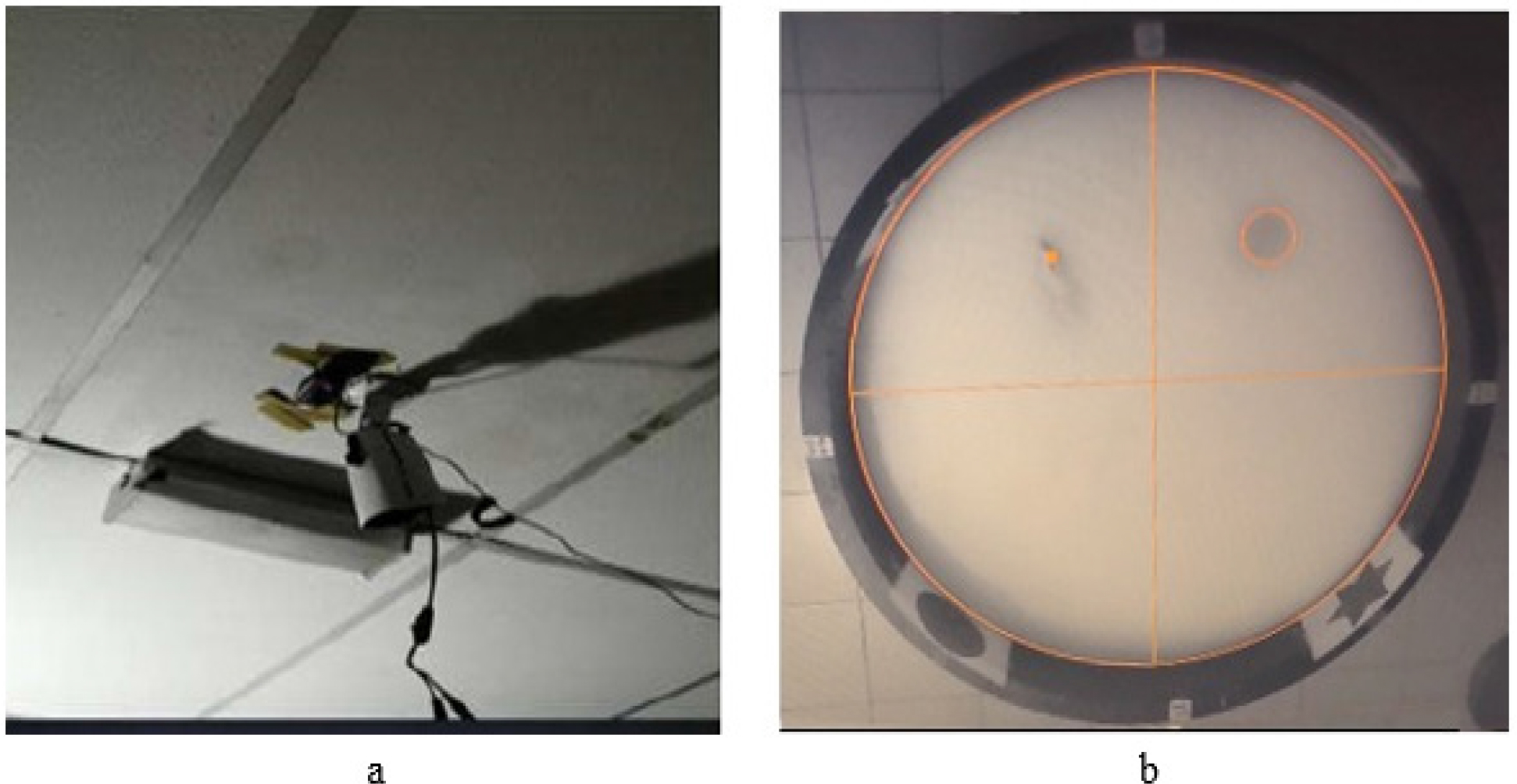
Figure 1:
Experimental setup of the MWM test. a) A Logitech camera was attached to the ceiling directly facing the MWM tank to record the rats’ movement. b) MWM tank filled with opaque water and divided into four equal quadrants using ANYmaze software. The escape platform was positioned at the centre of the designated quadrant (yellow circle).
Day one experiment began by training the rats to find the floating visible escape platform (2 cm above the water level). The next four consecutive days involve training the rats to locate the hidden escape platform (now submerged 2 cm below the water level). Meanwhile, the escape platform quadrant was maintained during the place navigation test for five days. During this test, each rat participated in three training sessions daily, where they were placed randomly in one of the three quadrants (starting point), excluding the quadrant containing the escape platform. The rats were then given a maximum of 120 sec to locate the hidden escape platform. Rats that successfully located the hidden escape platform were allowed to remain on it for 20 sec to facilitate their recognition and familiarisation with the platform’s position. Those unable to locate the hidden platform within the designated time were guided towards it and allowed to remain there for 20 sec. The hidden platform was then removed from the targeted quadrant 24 hr after the place navigation test was completed. The rats were placed in the opposite quadrant of the water tank and permitted to explore the removed escape platform for 30 sec. The ANYmaze software was linked to the video camera and recorded all the required parameters, including the swimming trajectory, escape latency, and the time spent at the targeted quadrant, for subsequent analyses.
Histological Study
Once the behavioural test was completed, the rats were decapitated, and their brains were immediately harvested and preserved for seven days in 10% neutral buffered formalin for histological analysis. A tissue processor (Leica TP1020) was used to perform a normal histological processing technique, and then the tissues were preserved in paraffin blocks, sectioned approximately 5 μm using a microtome, and stained with 0.1% of cresyl violet. The histological slides were viewed under a compound research microscope (Olympus BX51 TRF) at 200X magnification. The number of viable pyramidal cells in CA1 subfield was counted. With the help of an independent pathologist, the quantification of viable pyramidal cells was conducted by summing the counts obtained from at least five randomly selected areas within the mid portion of CA1 subfield, with the sample size of five rats per group (n=5).17
Immunohistochemical Staining
Paraffin-embedded sections of the rat brain tissues (4 μm thick) were attached to a salinised slide and left to dry at room temperature. The slides were baked at 60°C for 2 hr 30 min before the tissues were deparaffinised, rehydrated, and soaked in EnVision™ FLEX Target Retrieval Solution for 30 min at 95°C. After 20 min, the tissues were removed from the antigen retrieval solution, rinsed in a washing buffer for 3 min twice, incubated in a blocking solution at room temperature for 30 min, and incubated with the respective primary antibodies: Glial Fibrillary Acidic Protein (GFAP) (1:2000 at room temperature for 20 min), Doublecortin (DCX) (0.5 μg/mL at 4°C overnight), Neuronal Nuclear protein marker (NeuN) (1:3000 at room temperature for 1 hr), and calbindin (1:1000 at room temperature for 1 hr). Subsequently, the tissues were rinsed with a washing buffer and further incubated with a secondary antibody, Goat Anti-Rabbit IgG H&L (HRP), for 15 min at room temperature. The tissues were rinsed again with a washing buffer and incubated with 0.05% (w/v) 3,3’-Diaminobenzidine (DAB) for 15 min. Finally, the slides were counter-stained with haematoxylin. Image J software was used to quantify the GFAP+ cells, calbindin+ cells, and DCX+ cells, as well as calculate the percentage of immunoreactive areas for NeuN.
Statistical Analysis
Statistical analysis was performed using SPSS software version 25.0, and all data from this study were presented as the mean±standard error of the mean (SEM). The learning trials of MWM were analysed by two-way ANOVA, while one-way ANOVA was used in the probe trial. One-way ANOVA was also utilised for other analyses, followed by Tukey’s post-hoc test. An outcome with p<0.05 was considered to be statistically significant.
RESULTS
Effect of Δ9THC on the Cognitive Deficits in D-gal/ AlCl3-induced Rats in MWM
Figure 2a shows the representative swimming trajectories of the rats on day 5 of the place navigation test (training trials). Accordingly, the AD model rats (Figure 2a) swam aimlessly at the periphery of the tank to locate the hidden escape platform. In comparison, rats from the control, donepezil, and Δ9THC groups swam purposefully towards the middle of the tank to locate the hidden escape platform. Based on the one-way ANOVA result, a statistically significant interaction was observed between the treatment effect and days of treatment [F (6,36)=5.871, p=0.001], indicating the impact of Δ9THC on the escape latency to reach the escape platform among the seven groups. Tukey’s post-hoc analysis also revealed a substantial increase (p<0.05) in the time needed for the rats from the AD model group and recovery group to locate the hidden escape platform throughout the five-day training than the control and treated groups (Figure 2b).

Figure 2:
Spatial learning and memory through MWM in rats. a) Representative of swimming trajectories on day-5 trial. b) The mean escape latency throughout the place navigation test. c) The mean time spent in the target quadrant during the probe test. Data are expressed as the mean±SEM (n=10). *p<0.05 vs AD model group; #p<0.05 vs recovery group.
Additionally, the one-way ANOVA showed a statistically significant difference [F (6,33)=3.123, p=0.016] in the duration of the rats staying in the targeted quadrant during the probe trial. As revealed by Tukey’s post-hoc, the AD model group (6.98±0.27) and recovery group (7.25±0.64) took significantly less time in the targeted quadrant compared to the control (15.4±1.92), 0.75 Δ9THC (14.47±3.28), 1.5 Δ9THC (14.61±1.95), and 3.0 Δ9THC (13.18±1.43) (Figure 2c). Therefore, the MWM results signify that Δ9THC attenuates cognitive deficits in D-gal/AlCl3-induced rats.
Influence of Δ9THC on the D-gal/AlCl3-induced Degeneration of the Hippocampal CA1 Neurons
Figures 3 and 4 depict the CA1 regions of the rat’s hippocampus from all groups histologically. The presence of numerous viable cells (light cytoplasm and dark nucleus) and well-arranged intact layers of pyramidal cells were detected in the control group. However, distorted pyramidal cell layers and several hyperchromic cells were found in the CA1 hippocampal areas of the AD model and recovery groups. Interestingly, the administration of donepezil and Δ9THC at varying concentrations alleviates some of the histological aberrations observed earlier.
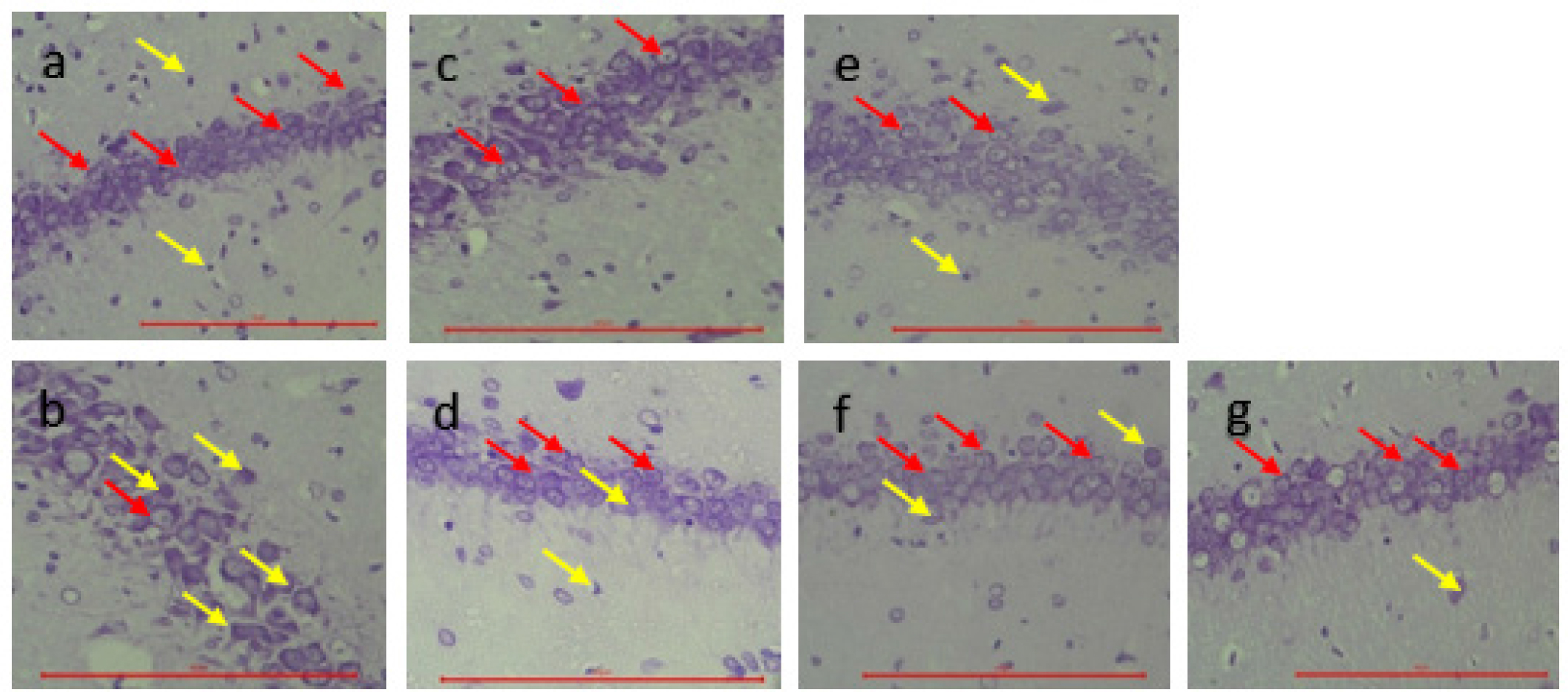
Figure 3:
Photomicrographs of the Nissl stained for all groups at the CA1 subfield of the rat hippocampus. The red and yellow arrows indicate viable and dead pyramidal cells, respectively. Image magnification=400X, scale bar=40 μm.
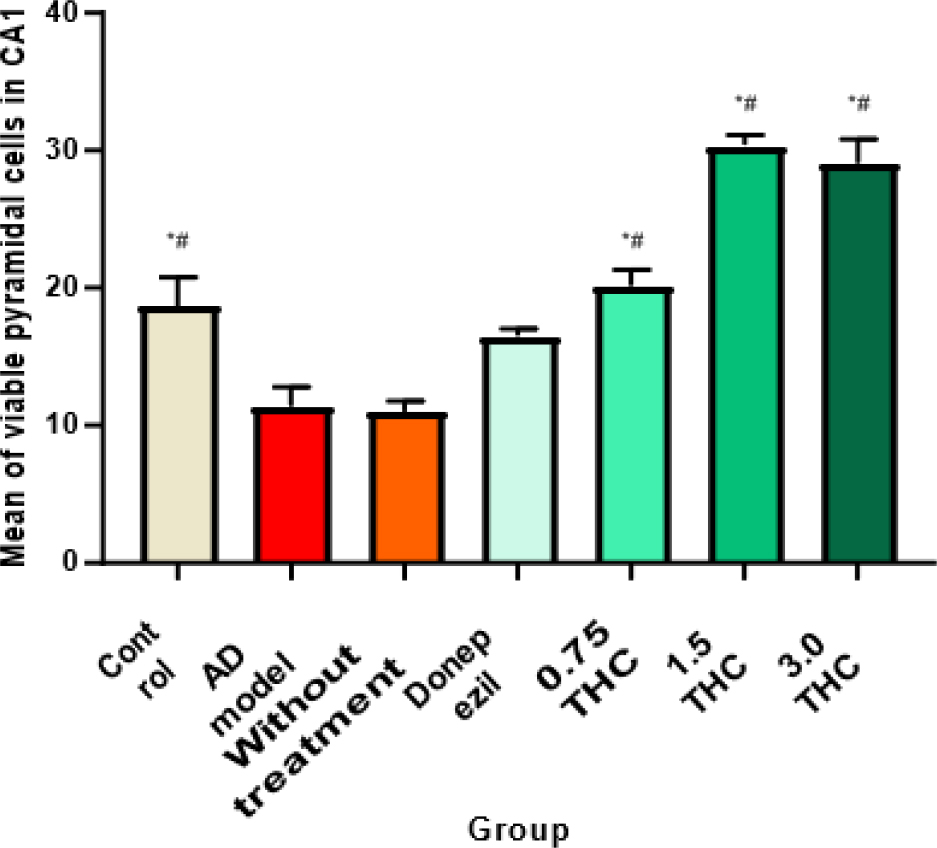
Figure 4:
Mean of viable pyramidal cells in the CA1 subfield of the hippocampus for all groups. Data are expressed as the mean±SEM (n=5). *p<0.05 vs AD model group; #p<0.05 vs recovery group.
Apart from that, the one-way ANOVA recorded statistically significant differences in the number of viable pyramidal cells in CA1 [F (6,49)=33.878, p=0.001] subfield of the hippocampus among the numerous sample groups. Tukey’s post-hoc test also recorded a statistically significant reduction (p<0.05) in the number of viable pyramidal cells within the CA1 subfield of the hippocampus in the AD model group (11.35±1.42) compared to the control group (18.65±2.08). Additionally, a statistically significant reduction (p<0.05) was also observed in the CA1 subfield of the hippocampus in the recovery group (10.98±0.78) compared to the control group. On the other hand, Tukey’s post-hoc test confirmed a significant increase of viable cells in the CA1 after being treated with 0.75 mg/kg Δ9THC (20.10±1.19), 1.5 mg/kg Δ9THC (30.35±0.72), and 3.0 mg/kg Δ9THC (29.00±1.76) compared to the AD model group and recovery group (Figures 3 and 4).
Influence of Δ9THC on the neurogenesis at the CA1 subfield of the Hippocampus in D- gal/AlCl3-induced rats
Figure 5a presents the expression of GFAP+ immunoreactive neurons in the CA1 subfield. The expression of GFAP+ in the CA1 region among all the rat groups was statistically significantly different (p<0.05), where the number of GFAP+ neurons was substantially upregulated in rats treated with donepezil (73.67±2.19) and Δ9THC at all doses; 0.75 Δ9THC (86.00±4.17), 1.5 Δ9THC (136.33±4.22), and 3.0 Δ9THC (113.5±4.11) compared to the AD model (35.33±1.74) and recovery groups (35.50±1.09) (p<0.001) (Figure 5b).

Figure 5:
a) Photomicrograph of the CA1 subfield of the hippocampus via immunohistochemical staining. The red arrows represent the GFAP+ cells. (a) Control, (b) AD model, (c) recovery, (d) donepezil, (e) 0.75 Δ9THC, (f) 1.5 Δ9THC, and (g) 3.0 Δ9THC. Image magnification=400X, scale bar=40 μm. b) Mean number of GFAP+cells±SEM at the CA1 region of the hippocampus. *p<0.001 vs AD model group; #p<0.001 vs recovery group.
Similar to GFAP+, the one-way ANOVA results recorded a statistically significant difference [F (6,35)=75.65, p=0.001] in the expression of DCX+ among all the rat groups. Tukey’s post-hoc test also showed a substantial increase (p<0.001) in the number of DCX+ cells in rats treated with donepezil (71.17±2.33), 0.75 Δ9THC (69.33±1.69), 1.5 Δ9THC (84.50±2.59), and 3.0 Δ9THC (77.17±2.04) compared to the AD model (35.00±1.41) and recovery groups (45.67±2.86) (Figure 6).

Figure 6:
a) Photomicrograph of the CA1 subfield of the hippocampus via immunohistochemical staining. The red arrows represent the DCX+ cells. Image magnification=400X, scale bar=40 μm. b) Mean number of DCX+ cells±SEM at the CA1 region of the hippocampus. *p<0.001 vs AD model group; #p<0.001 vs recovery group.
Besides, the one-way ANOVA demonstrated a statistically significant difference [F (6,35)=54.6, p=0.001] in the expression of NeuN+ among all the rat groups. Evidently, Tukey’s post-hoc test confirmed a marked increase (p<0.001) in the percentage of NeuN+ immunoreactive area in rats treated with donepezil (5.61±0.31), 0.75 Δ9THC (12.66±1.10), 1.5 Δ9THC (13.63±1.03), and 3.0 Δ9THC (13.04±0.87) compared to the AD model (1.90±0.34) and recovery groups (2.07±0.37) (Figure 7a and 7b).
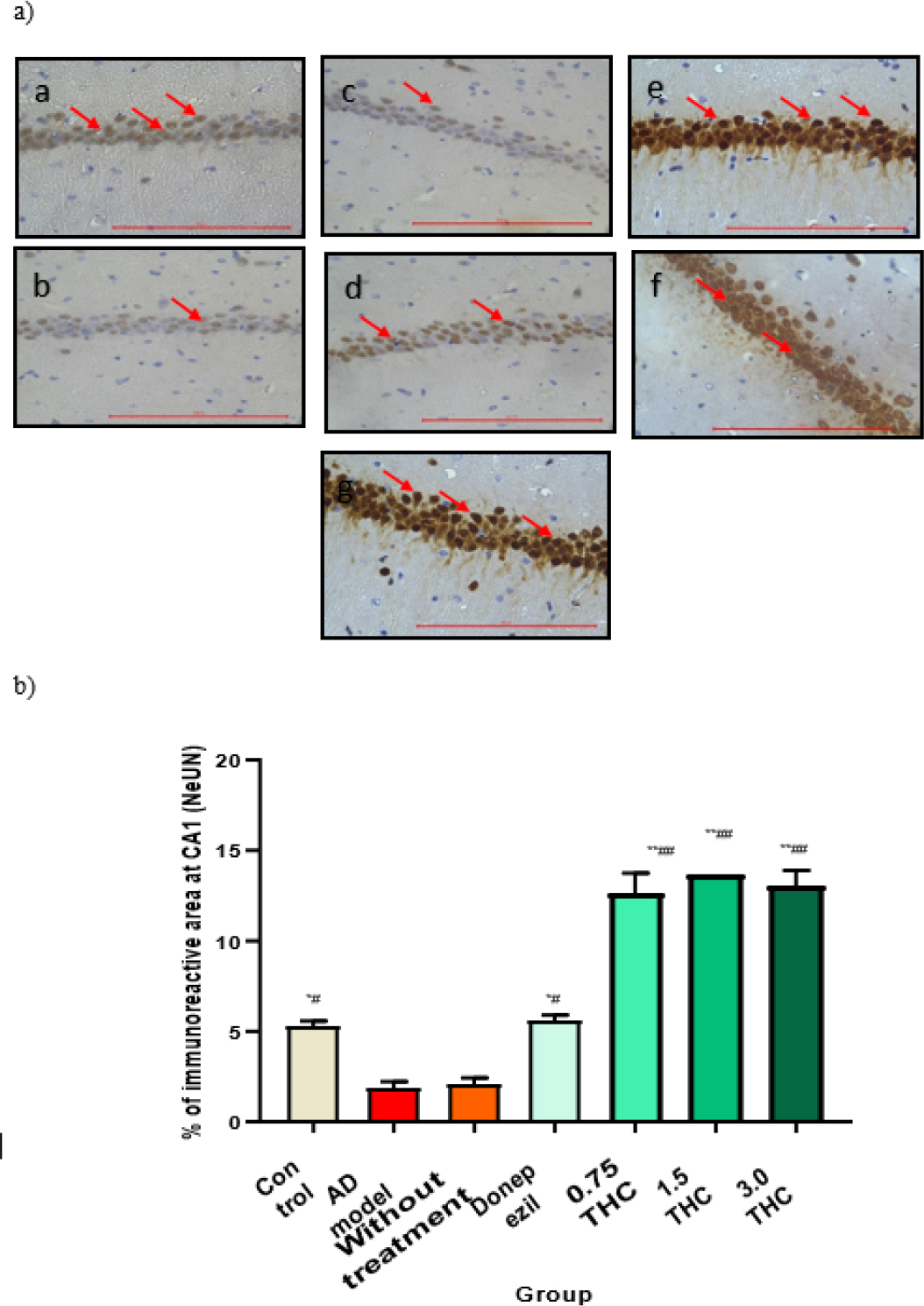
Figure 7:
a) Photomicrograph of the CA1 subfield of the hippocampus via immunohistochemical staining. The red arrows represent the NeuN+ cells. Image magnification=400X, scale bar=40 μm. b) Percentage of immunoreactive area of NeuN+ cells±SEM at the CA1 region of the hippocampus. *p<0.05, **p<0.001 vs AD model group; #p<0.05, ##p<0.001 vs recovery group.
In terms of the calbindin+ cell marker in Figure 8a, the result shows a statistically significant reduction [F(6,35)=58.38, p=0.001] in the number of calbindin+ cells, both in the AD model and recovery groups compared to the control. In contrast, a marked increase (p<0.001) in the number of calbindin+ cells were detected in all treated groups compared to the AD model and recovery groups (Figure 8b). In short, Δ9THC stimulates neurogenesis at the CA1 region in D- gal/AlCl3-induced rats.
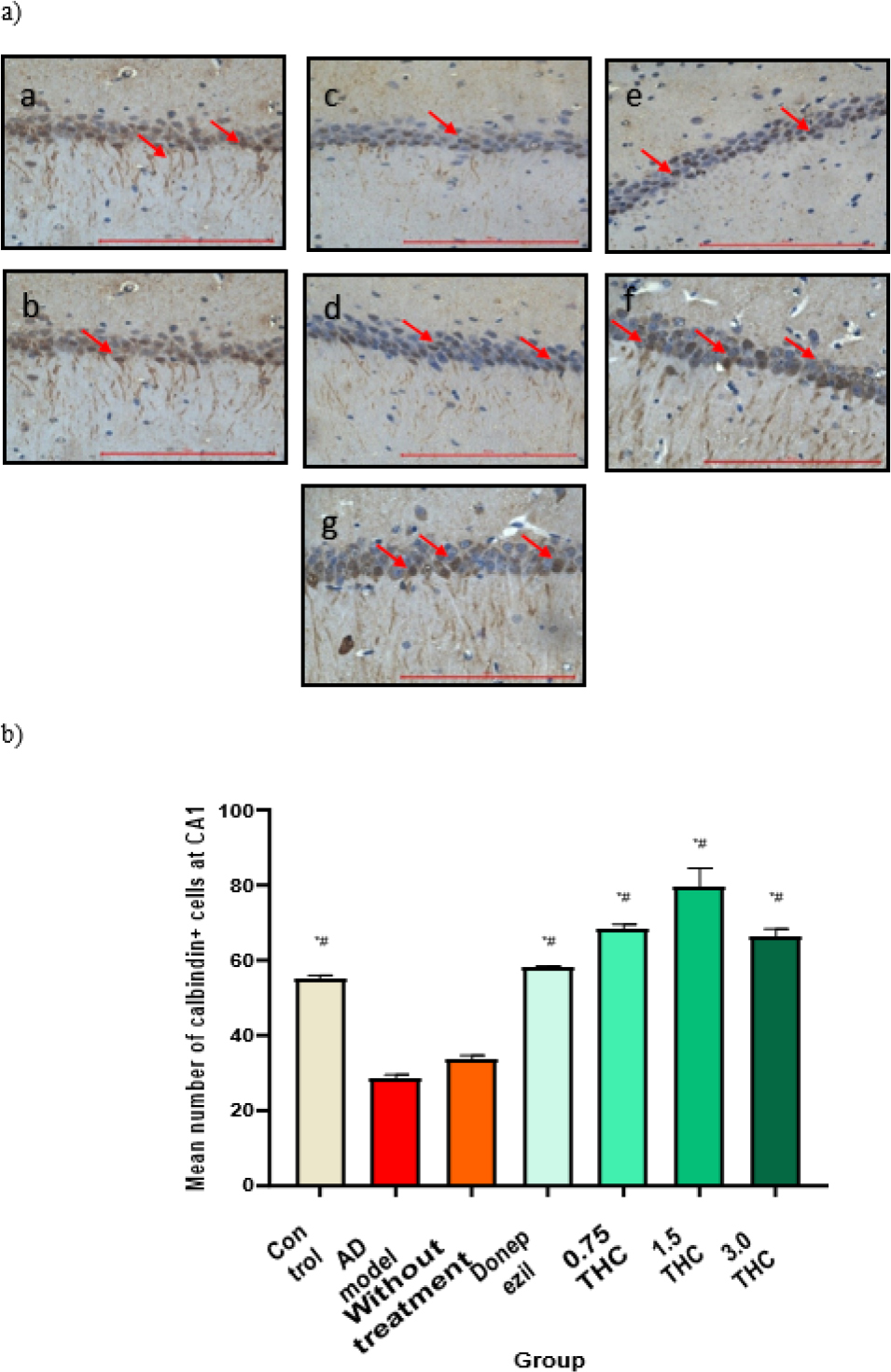
Figure 8:
a) Photomicrograph of the CA1 subfield of the hippocampus via immunohistochemical staining. The red arrows represent the calbindin+ cells. Image magnification=400X, scale bar=40 μm. b) Mean number of calbindin+ cells±SEM at the CA1 region of the hippocampus. *p<0.001 vs AD model group; #p<0.001 vs recovery group.
DISCUSSION
AD Induction in Rats Model and Potential Treatment with Δ9THC
Chronic administration of D-gal/AlCl3 over 10 consecutive weeks resulted in AD-like symptoms in the rat models, as indicated by the reduced spatial learning and memory, neurodegeneration, and morphological alteration of their hippocampal neurons. A decreased neurogenesis activity was also observed. Similar trends have been reported in previous studies, where the administration of D-gal/AlCl3 induced neurodegenerative alterations similar to AD, such as cognitive dysfunction,18 cell depletion in the hippocampus, and high expression of amyloid and tau proteins.19,20 Nevertheless, the present study showed that the Δ9THC treatment ameliorates the reported AD-like symptoms in the rat model, comparable to that of donepezil, an FDA-approved sedative drug for AD treatment.
Evaluation of Behavioural Effects Based on MWM
Evaluating behavioural effects is a critical component of the in vivo drug screening in rats prior to further assessments.21 MWM is an established model used for studying learning and behaviour in rats and relies on the distal cues to locate the platform submerged in opaque water.22 The swimming trajectories of rats administered with D-gal/AlCl3 (AD model) and recovery groups were directionless and random at the periphery of the tank, requiring more time to reach the hidden platform, thus indicating learning and memory impairments. The result from this study was in line with previous findings, which also reported cognitive impairments in D-gal/AlCl3-induced AD-like rat models.18,19
However, rats treated with donepezil and Δ9THC (regardless of the dosage) showed progressively active search and reached the hidden platform in a shorter time, signifying improved learning and memory processes. Moreover, treatment with Δ9THC in this study reduced the cognitive impairment caused by D-gal/AlCl3, as evidenced by the rats’ shorter escape latency to reach the hidden platform and the more time spent at the target quadrant during the probe trial test. Therefore, the findings suggest enhanced spatial learning and memory in the rats.
From the clinical perspective, the hippocampus is an initial region of the brain to be impacted by AD.23 The histology result of the present study indicated that the administered D-gal/AlCl3 caused severe degeneration of cells in the rats’ hippocampal subfields and disoriented pyramidal cell layers. This situation could disrupt the hippocampal functions. Interestingly, the findings revealed that Δ9THC has a strong neurotherapeutic potential in restoring some of the morphological aberrations and neurodegeneration of the hippocampus.
Assessment of Neurogenesis Markers
Neurogenesis is the development of new neurons from progenitor cells.24 This process has been linked to hippocampal-dependent learning and memory. Neurogenesis occurs through five stages, with each stage associated with specific protein expressions: proliferation (GFAP), differentiation (NeuN), migration (DCX), and axonal and dendritic targeting and synaptic integration (calbindin).25 The present study showed that Δ9THC treatment promoted neurogenesis activities in the hippocampus of D-gal/ AlCl3-induced rats, suggesting a strong neurotherapeutic effect. Our findings were parallel with previous studies demonstrated that acute and chronic administration of Δ9THC has also reported promoting neurogenesis in their hippocampus of normal rats.14
GFAP is an intermediate filament-III protein found in the central nervous system (CNS), which is abundantly high in astrocytes.26 GFAP is critical in maintaining the blood-brain barrier and provides mechanical strength to the astrocytes.26,27 In this study, the upregulation of GFAP expression in Δ9THC-treated rats suggest increased proliferation activity of neuronal cells that occurred in the hippocampus. Thus, it was postulated that Δ9THC enhanced the neuroblasts and new neuron production in the hippocampus due to the enhanced expression of GFAP.
Rats treated with Δ9THC also demonstrated an upregulation of DCX expression in the CA1 subfield of the hippocampus, implying the migration stage of neurogenesis.28 The result suggests that Δ9THC accelerates the migration of neuroblasts and young neurons from neurogenic zones, which aligns with previous studies.25 Findings from this study also showed a significantly increased NeuN immunoreactivity in the hippocampus of Δ9THC-treated rats. Within the hippocampus, NeuN can be used as a marker of postmitotic neurons.25 Meanwhile, calbindin is dynamically involved in synaptic plasticity modulation, which influences learning and memory processes. Chronic administration of D-gal/AlCl3 in rats demonstrated reduced calbindin+ cells in the CA1 subfield. The declined expression of calbindin+ cells is strongly correlated with impaired hippocampus-dependent memory in rats.29 On the contrary, rats treated with Δ9THC showed an upregulation of calbindin+ cells in the CA1 of the hippocampus, indicating strong synaptic integration that improved the memory process.
CONCLUSION
In conclusion, chronic exposure to D-gal/AlCl3 in rats causes behavioural and cognitive dysfunction, histological aberration in their hippocampus and retarding the neurogenesis activity. However, treatments with Δ9THC alleviate the aforementioned changes. Therefore, Δ9THC could be a valuable medical remedy particularly in improving cognition through neurogenesis.
Cite this article
Zakaria FN, Moklas MAM, Baharuldin MTH, Taib CNM, Hamid HA, Hamid HA, et al. Delta-9-tetrahydrocannabinol Ameliorates D-galactose/ Aluminium Chloride-Induced Alzheimer’s-Like Cognitive Deficit in Rats via Neurogenesis in their Hippocampus. J Young Pharm. 2024;16(1):33-41.
ACKNOWLEDGEMENT
This study was funded by Ministry of Higher Education through Fundamental Research Grant Scheme (FRGS) with code FRGS/1/2019/SKK06/UiTM/03/6 and Universiti Putra Malaysia (Grant number 9692900- 14001-P27799).
ABBREVIATIONS
| NFTs | Neurofibrillary Tangles |
|---|---|
| SPs | Senile Plaques |
| D-gal | D-galactose |
| AlCl3 | Aluminium chloride |
| AChE | acetylcholinesterase |
| MWM | Morris Water Maze |
| GFAP | Glial fibrillary acidic protein |
| DCX | Doublecortin |
| NeuN | Neuronal nuclear protein |
References
- Winblad B, Amouyel P, Andrieu S, Ballard C, Brayne C, Brodaty H, et al. Defeating Alzheimer’s disease and other dementias: a priority for European science and society. Lancet Neurol. 2016;15(5):455-532. [PubMed] | [CrossRef] | [Google Scholar]
- Kandimalla R, Reddy PH. Multiple faces of dynamin-related protein 1 and its role in Alzheimer’s disease pathogenesis. Biochim Biophys Acta. 2016;1862(4):814-28. [PubMed] | [CrossRef] | [Google Scholar]
- Huang Y, Mucke L. Alzheimer mechanisms and therapeutic strategies. Cell. 2012;148(6):1204-22. [PubMed] | [CrossRef] | [Google Scholar]
- Neddens J, Temmel M, Flunkert S, Kerschbaumer B, Hoeller C, Loeffler T, et al. Phosphorylation of different tau sites during progression of Alzheimer’s disease. Acta Neuropathol Commun. 2018;6(1):52 [PubMed] | [CrossRef] | [Google Scholar]
- Yang H, Qu Z, Zhang J, Huo L, Gao J, Gao W, et al. Ferulic acid ameliorates memory impairment in d-galactose-induced aging mouse model. Int J Food Sci Nutr. 2016;67(7):806-17. [PubMed] | [CrossRef] | [Google Scholar]
- Qu Z, Zhang J, Yang H, Huo L, Gao J, Chen H, et al. Protective effect of tetrahydropalmatine against d-galactose induced memory impairment in rat. Physiol Behav. 2016;154:114-25. [PubMed] | [CrossRef] | [Google Scholar]
- Chiroma SM, Mohd Moklas MA, Mat Taib CN, Baharuldin MTH, Amon Z. d-galactose and aluminium chloride induced rat model with cognitive impairments. Biomed Pharmacother. 2018;103:1602-8. [PubMed] | [CrossRef] | [Google Scholar]
- Aso E, Ferrer I. Cannabinoids for treatment of Alzheimer’s disease: moving toward the clinic. Front Pharmacol. 2014:1-11. [PubMed] | [CrossRef] | [Google Scholar]
- Nidadavolu P, Bilkei-Gorzo A, Krämer M, Schürmann B, Palmisano M, Beins EC, et al. Efficacy of Δ9 -Tetrahydrocannabinol (THC) alone or in combination with a 1: 1 ratio of cannabidiol (CBD) in reversing the spatial learning deficits in old mice. Front Aging Neurosci. 2021;13:718850 [PubMed] | [CrossRef] | [Google Scholar]
- Schubert D, Kepchia D, Liang Z, Dargusch R, Goldberg J. Platform for Alzheimer’s disease. 2020;56(11):7719-30. [PubMed] | [CrossRef] | [Google Scholar]
- Currais A, Quehenberger OM, Armando AM, Daugherty D, Maher P, Schubert D, et al. Amyloid proteotoxicity initiates an inflammatory response blocked by cannabinoids. npj Aging Mech Dis. 2016;2(1):16012 [PubMed] | [CrossRef] | [Google Scholar]
- Chiroma SM, Baharuldin MTH, Mat Taib CN, Amom Z, Jagadeesan S, Ilham Adenan M, et al. Protective effects of Centella asiatica on cognitive deficits induced by D-gal/ AlCl3 via inhibition of oxidative stress and attenuation of acetylcholinesterase level. Toxics. 2019;7(2) [PubMed] | [CrossRef] | [Google Scholar]
- Song W, Hooli B, Mullin K, Jin SC, Cella M, Ulland TK, et al. Alzheimer’s disease-associated TREM2 variants exhibit either decreased or increased ligand-dependent activation. Alzheimers Dement. 2017;13(4):381-7. [PubMed] | [CrossRef] | [Google Scholar]
- Suliman NA, Taib CNM, Moklas MAM, Basir R. Delta-9-tetrahydrocannabinol (Δ9-THC) induce neurogenesis and improve cognitive performances of male Sprague Dawley rats. Neurotox Res. 2018;33(2):402-11. [PubMed] | [CrossRef] | [Google Scholar]
- Vorhees CV, Williams MT. Morris water maze: procedures for assessing spatial and related forms of learning and memory. Nat Protoc. 2006;1(2):848-58. [PubMed] | [CrossRef] | [Google Scholar]
- Chiroma SM, Hidayat Baharuldin MT, Mat Taib CN, Amom Z, Jagadeesan S, Adenan MI, et al. Protective effect of Centella asiatica against D -galactose and aluminium chloride induced rats: behavioral and ultrastructural approaches. Biomed Pharmacother. 2019;109(2018):853-64. [PubMed] | [CrossRef] | [Google Scholar]
- Mahdi O, Chiroma SM, Hidayat Baharuldin MT, Mohd Nor NH, Mat Taib CN, Jagadeesan S, et al. Win55,212-2 attenuates cognitive impairments in AlCl3+ d-galactose-induced Alzheimer’s disease rats by enhancing neurogenesis and reversing oxidative stress. Biomedicines. 2021;9(9):1-22. [PubMed] | [CrossRef] | [Google Scholar]
- Zhang Y, Pi Z, Song F, Liu Z. Ginsenosides attenuate D-galactose- and AlCl3-inducedspatial memory impairment by restoring the dysfunction of the neurotransmitter systems in the rat model of Alzheimer’s disease. J Ethnopharmacol. 2016;194:188-95. [PubMed] | [CrossRef] | [Google Scholar]
- Wei Y, Liu D, Zheng Y, Li H, Hao C, Ouyang W, et al. Protective effects of kinetin against aluminum chloride and D-galactose induced cognitive impairment and oxidative damage in mouse. Brain Res Bull. 2017;134:262-72. [PubMed] | [CrossRef] | [Google Scholar]
- Xiao F, Li XG, Zhang XY, Hou JD, Lin LF, Gao Q, et al. Combined administration of D-galactose and aluminium induces Alzheimerlike lesions in brain. Neurosci Bull. 2011;27(3):143-55. [PubMed] | [CrossRef] | [Google Scholar]
- Karl T, Pabst R, von Hörsten S. Behavioral phenotyping of mice in pharmacological and toxicological research. Exp Toxicol Pathol. 2003;55(1):69-83. [PubMed] | [CrossRef] | [Google Scholar]
- Wang X, Xi Y, Zeng X, Zhao H, Cao J, Jiang W, et al. Effects of chlorogenic acid against aluminium neurotoxicity in ICR mice through chelation and antioxidant actions. J Funct Foods. 2018;40:365-76. [CrossRef] | [Google Scholar]
- Bingman VP. The importance of comparative studies and ecological validity for understanding hippocampal structure and cognitive function. Hippocampus. 1992;2(3):213-9. [PubMed] | [CrossRef] | [Google Scholar]
- Kempermann G, Song H, Gage FH. Neurogenesis in the adult hippocampus. Cold Spring Harb Perspect Biol. 2015;7(9):a018812 [PubMed] | [CrossRef] | [Google Scholar]
- Bohlen V, Halbach O. Immunohistological markers for staging neurogenesis in adult hippocampus. Cell Tissue Res. 2007;329(3):409-20. [PubMed] | [CrossRef] | [Google Scholar]
- McKeon A, Benarroch EE. Glial fibrillary acid protein: functions and involvement in disease. Neurology. 2018;90(20):925-30. [PubMed] | [CrossRef] | [Google Scholar]
- Eng LF, Ghirnikar RS, Lee YL. Glial fibrillary acidic protein: GFAP-thirty-one years (1969-2000). Neurochem Res. 2000;25(9-10):1439-51. [PubMed] | [CrossRef] | [Google Scholar]
- Rao MS, Shetty AK. Efficacy of doublecortin as a marker to analyse the absolute number and dendritic growth of newly generated neurons in the adult dentate gyrus. Eur J Neurosci. 2004;19(2):234-46. [PubMed] | [CrossRef] | [Google Scholar]
- Sun B, Zhou Y, Halabisky B, Lo I, Cho S, Wang X, et al. NIH public access. 2009;60(2):247-57. [PubMed] | [CrossRef] | [Google Scholar]
